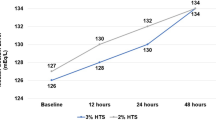Abstract
Background and Purpose
Hypertonic saline (3% NaCl) infusions can be used to treat acute neurologic hyponatremia (ANH) in critically ill patients with neurological and neurosurgical disorders such as subarachnoid hemorrhage. Adjustments in the rate of hypertonic saline infusions to treat ANH are needed to achieve a goal sodium range and are usually made on an empiric basis. To date, no data are available to determine how reliably such adjustments achieve stable, normal serum sodium concentrations or how often iatrogenic hypernatremia occurs during the course of treatment with hypertonic saline.
Methods
We have instituted a standardized sliding-scale hypertonic saline protocol to minimize patient-to-patient variability of hypertonic saline administration and to attempt to achieve safe rates of sodium correction and stable maintenance of serum sodium concentration with minimal overshoot. Here, we present a retrospective analysis of the performance characteristics of our standardized hypertonic saline protocol over a 1-year period, in 49 patients.
Results
The mean rate of initial sodium correction was 0.44 ± 0.36 (mEq/l)/h. During the maintenance infusion phase, 84.3 ± 17.8% of the time was spent in goal range (Na 136–145 mEq/l), 14.9 ± 18.1% of the time was spent in mild undershoot (Na 130–135 mEq/l), and 0.7 ± 3.1% of the time was spent in overshoot (Na >145 mEq/l). No adverse events attributable to infusion of hypertonic saline were encountered.
Conclusion
Our hypertonic saline sliding-scale protocol for treatment of ANH can be used reliably and achieves normal sodium concentrations in a safe manner with minimal overshoot.


Similar content being viewed by others
References
Palmer B. Hyponatremia in patients with central nervous system disease: SIADH versus CSW. Trends Endocrinol Metab. 2003;14(4):182–7. doi:10.1016/S1043-2760(03)00048-1.
Cole C, Gottfried O, Liu J, Couldwell W. Hyponatremia in the neurosurgical patient: diagnosis and management. Neurosurg Focus. 2004;16(4):E9. doi:10.3171/foc.2004.16.4.10.
Singh S, Bohn D, Carlotti A, et al. Cerebral salt wasting: truths, fallacies, theories, and challenges. Crit Care Med. 2002;30(11):2575–9. doi:10.1097/00003246-200211000-00028.
Sherlock M, O’Sullivan E, Agha A, et al. The incidence and pathophysiology of hyponatraemia after subarachnoid haemorrhage. Clin Endocrinol (Oxf). 2006;64(3):250–4. doi:10.1111/j.1365-2265.2006.02432.x.
Peters J, Welt L, Sims E, Orloff J, Needham J. A salt-wasting syndrome associated with cerebral disease. Trans Assoc Am Physicians. 1950;63:57–64.
von Bismarck P, Ankermann T, Eggert P, et al. Diagnosis and management of cerebral salt wasting (CSW) in children: the role of atrial natriuretic peptide (ANP) and brain natriuretic peptide (BNP). Childs Nerv Syst. 2006;22(10):1275–81. doi:10.1007/s00381-006-0091-x.
Harrigan M. Cerebral salt wasting syndrome: a review. Neurosurgery. 1996;38(1):152–60. doi:10.1097/00006123-199601000-00035.
Harrigan M. Cerebral salt wasting syndrome. Crit Care Clin. 2001;17(1):125–38. doi:10.1016/S0749-0704(05)70155-X.
Isotani E, Suzuki R, Tomita K, et al. Alterations in plasma concentrations of natriuretic peptides and antidiuretic hormone after subarachnoid hemorrhage. Stroke. 1994;25(11):2198–203.
Berendes E, Walter M, Cullen P, et al. Secretion of brain natriuretic peptide in patients with aneurysmal subarachnoid haemorrhage. Lancet. 1997;349(9047):245–9. doi:10.1016/S0140-6736(96)08093-2.
Carlotti A, Bohn D, Rutka J, et al. A method to estimate urinary electrolyte excretion in patients at risk for developing cerebral salt wasting. J Neurosurg. 2001;95(3):420–4.
Coenraad M, Meinders A, Taal J, Bolk J. Hyponatremia in intracranial disorders. Neth J Med. 2001;58(3):123–7. doi:10.1016/S0300-2977(01)00087-0.
Froelich M, Ni Q, Wess C, Ougorets I, Härtl R. Continuous hypertonic saline therapy and the occurrence of complications in neurocritically ill patients. Crit Care Med. 2009;37(4):1433–41.
Hasan D, Lindsay KW, Wijdicks EF, et al. Effect of fludrocortisone acetate in patients with subarachnoid hemorrhage. Stroke. 1989;20(9):1156–61.
Wijdicks EFM. The clinical practice of critical care neurology. 2nd ed. Oxford, UK: Oxford University Press; 2003.
Wijdicks EF, Vermeulen M, Hijdra A, van Gijn J. Hyponatremia and cerebral infarction in patients with ruptured intracranial aneurysms: is fluid restriction harmful? Ann Neurol. 1985;17(2):137–40. doi:10.1002/ana.410170206.
Wijdicks EF, Vandongen KJ, Vangijn J, Hijdra A, Vermeulen M. Enlargement of the third ventricle and hyponatraemia in aneurysmal subarachnoid haemorrhage. J Neurol Neurosurg Psychiatr. 1988;51(4):516–20. doi:10.1136/jnnp.51.4.516.
Adrogue HJ, Madias NE. Hyponatremia. N Engl J Med. 2000;342(21):1581–9. doi:10.1056/NEJM200005253422107.
Ropper AH, Gress DR, Diringer MN, Green DM, Mayer SA. Neurological and neurosurgical intensive care. 4th ed. Philadelphia, PA: Lippincott Williams & Wilkins; 2003.
Mosteller R. Simplified calculation of body-surface area. N Engl J Med. 1987;317(17):1098.
Fisher L, Ko N, Miss J, et al. Hypernatremia predicts adverse cardiovascular and neurological outcomes after SAH. Neurocrit Care. 2006;5(3):180–5. doi:10.1385/NCC:5:3:180.
Bentsen G, Stubhaug A, Eide PK. Differential effects of osmotherapy on static and pulsatile intracranial pressure. Crit Care Med. 2008;36(8):2414–9. doi:10.1097/CCM.0b013e318180fe04.
Infanti JL. Challenging the gold standard: should mannitol remain our first-line defense against intracranial hypertension? J Neurosci Nurs. 2008;40(6):362–8. doi:10.1097/01376517-200812000-00009.
Jantzen JAH. Prevention and treatment of intracranial hypertension. Best Pract Res Clin Anaesthesiol. 2007;21(4):517–38. doi:10.1016/j.bpa.2007.09.001.
Oddo M, Levine JM, Frangos S, et al. Effect of mannitol and hypertonic saline on cerebral oxygenation in patients with severe traumatic brain injury and refractory intracranial hypertension. J Neurol Neurosurg Psychiatr. 2009; Mar 16 [Epub ahead of print].
Author information
Authors and Affiliations
Corresponding author
Rights and permissions
About this article
Cite this article
Woo, C.H., Rao, V.A., Sheridan, W. et al. Performance Characteristics of a Sliding-Scale Hypertonic Saline Infusion Protocol for the Treatment of Acute Neurologic Hyponatremia. Neurocrit Care 11, 228–234 (2009). https://doi.org/10.1007/s12028-009-9238-4
Received:
Accepted:
Published:
Issue Date:
DOI: https://doi.org/10.1007/s12028-009-9238-4




